Lots of interesting abstracts and cases were submitted for TCTAP 2023. Below are the accepted ones after a thorough review by our official reviewers. Don’t miss the opportunity to expand your knowledge and interact with authors as well as virtual participants by sharing your opinion in the comment section!
TCTAP A-055
A Comparison of Pharmaco-Mechanical Thrombolysis and Catheter-Directed Thrombosis for Treatment of Thromboembolic Occlusion of Lower Limb – An Observational Case-Control Study.
By Chun-Cheng Wang, Chung-Ho Hsu, Chiung-Ray Lu, Yukai Lin
Presenter
Chung-Ho Hsu
Authors
Chun-Cheng Wang1, Chung-Ho Hsu2, Chiung-Ray Lu2, Yukai Lin2
Affiliation
Tzu Chi General Hospital, Taiwan1, China Medical University Hospital, Taiwan2
View Study Report
TCTAP A-055
Peripheral Vascular Disease and Intervention
A Comparison of Pharmaco-Mechanical Thrombolysis and Catheter-Directed Thrombosis for Treatment of Thromboembolic Occlusion of Lower Limb – An Observational Case-Control Study.
Chun-Cheng Wang1, Chung-Ho Hsu2, Chiung-Ray Lu2, Yukai Lin2
Tzu Chi General Hospital, Taiwan1, China Medical University Hospital, Taiwan2
Background
Percutaneous endovascular treatment for acute limb ischemia has gained more interest due to its less invasiveness and efficacy compared with surgical thrombectomy. Whether pharmaco-mechanical thrombolysis (PMT) could provide a better outcome than simple catheter-directed thrombolysis (CDT) required validation.
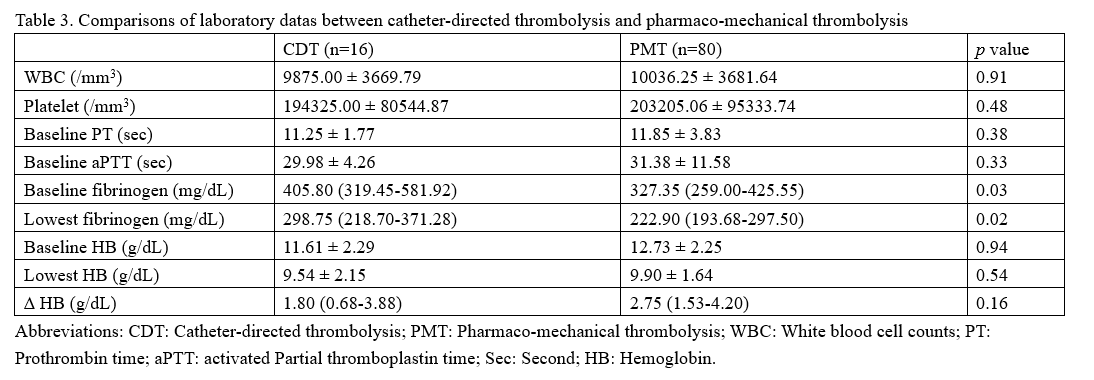

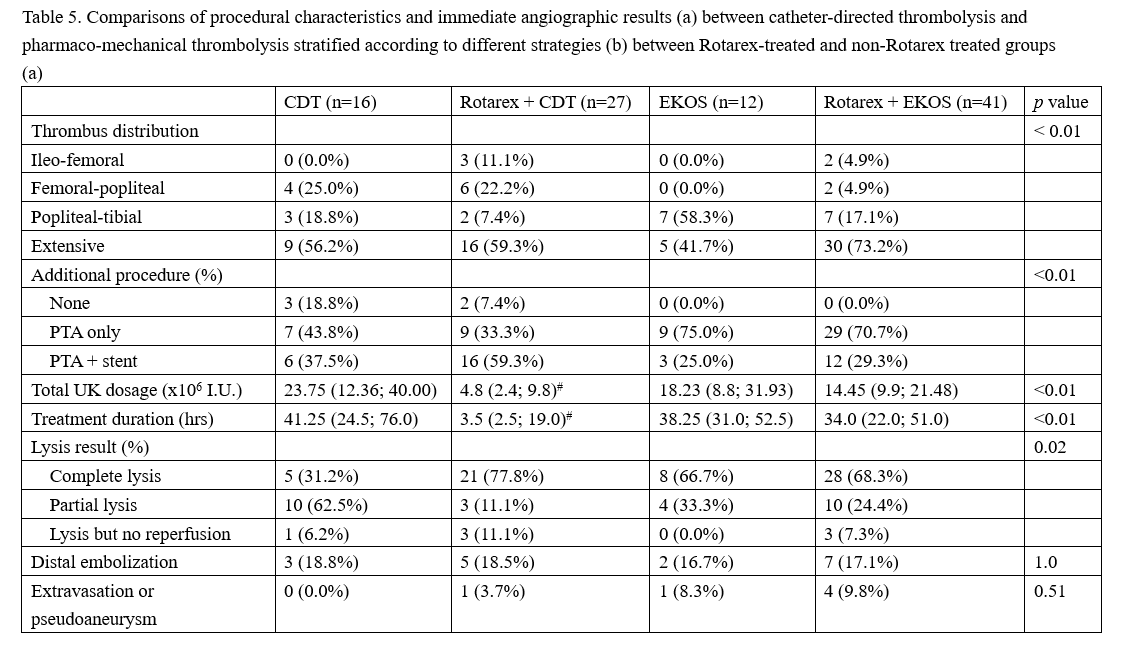



Methods
From October 2016 to April 2020, a total of 96 patients who presented with acute or subacute thromboembolic occlusion at lower limbs and received emergent endovascular treatment were enrolled. Patients were divided into 2 groups (CDT group: n= 16, PMT group: n = 80) according to the different treatment strategies. Baseline demographics, laboratory data, angiographic and clinical outcomes were collected by chart review and cinematographic imaging. The procedural characteristics (total thrombolytic dosage, treatment duration, additional procedures), immediate angiographic outcome (patency of calf vessels, complete lysis rate), complications (major bleeding, vessel extravasation, perforation, compartment syndrome), and early clinical outcomes (30-day mortality, amputation, reocclusion requiring intervention) were compared between the two groups.
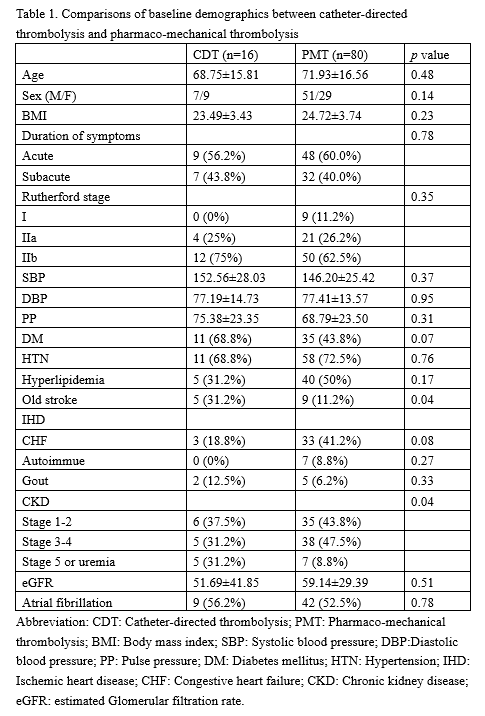
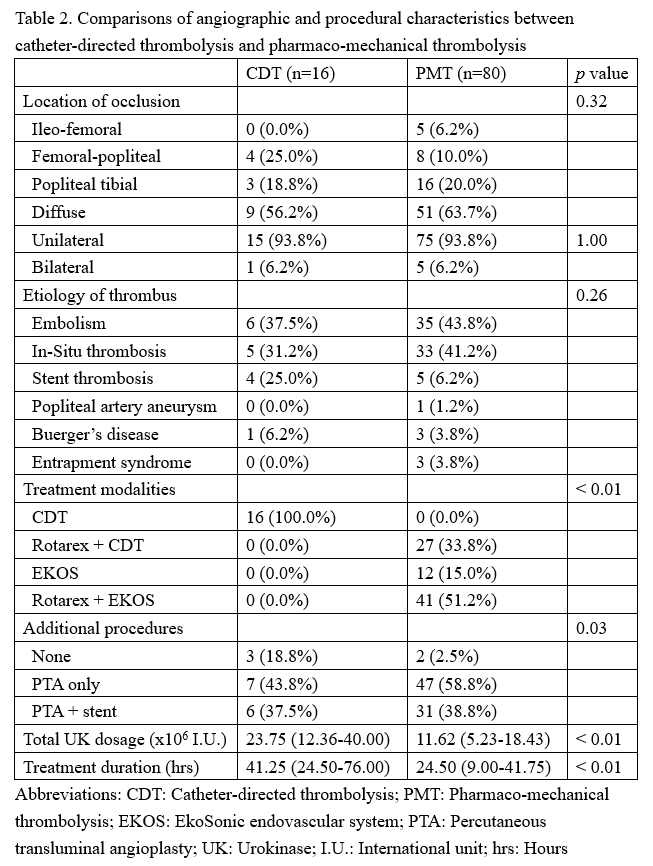


Results
Overall, procedural success rate is 93.8%. 64.58% of the total study subjects have moderate to severe lower limb ischemia (Rutherford class IIb). 53.13% of all have atrial fibrillation during presentation at hospital. 62.5% of the total study subjects have diffuse thrombus distribution from iliofemoral segment down to calf arteries. 6.25% of the total subjects have thrombotic occlusions at bilateral lower limbs. 42.71% of the total subjects have embolic occlusion, and 39.58% of the total study subjects have in-situ thrombosis due to atherosclerosis or hypercoagulability. Compared with the CDT group, the PMT group had a significantly lower thrombolytic drug dosage [11.62 x106 I.U. (5.23 x106 I.U.-18.43 x106 I.U.) vs. 23.75 x106 I.U. (12.36 x106 I.U.- 40.00 x106 I.U.); p < 0.01], a shorter duration of thrombolysis [24.50 hrs (9.00 hrs - 41.75 hrs) vs. 41.25 hrs (24.50 hrs - 76.00 hrs); p < 0.01] required for reestablishment of limb perfusion, and had a significantly higher proportion of complete lysis of the thrombus (71.2% vs. 31.2%; p < 0.01). The major bleeding rate (7.5% vs. 0.0%; p = 0.59), compartment syndrome requiring fasciotomy (6.2% vs. 0.0%; p = 0.59), and risks of 30-day mortality (2.5% vs. 6.2%, p = 0.43), amputation (2.5% vs. 6.2%, p = 0.43), reocclusion (2.5% vs. 6.2%, p = 0.43) were comparable between the two groups.
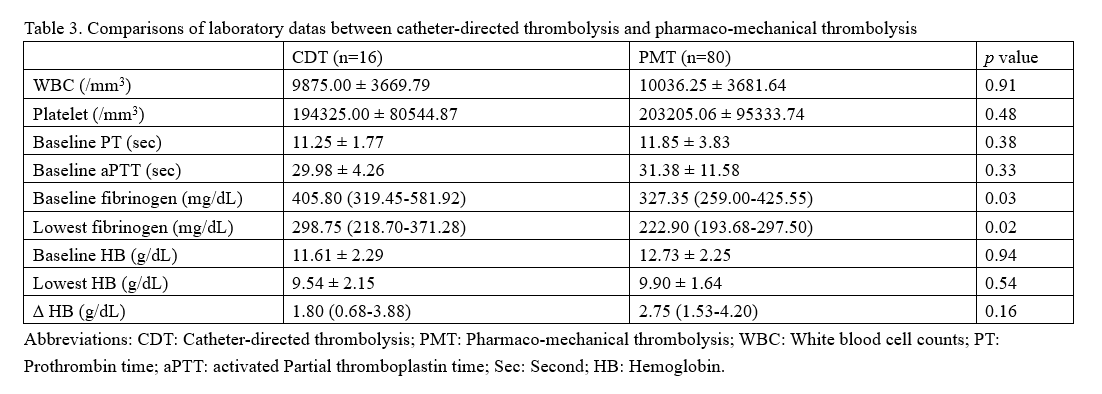
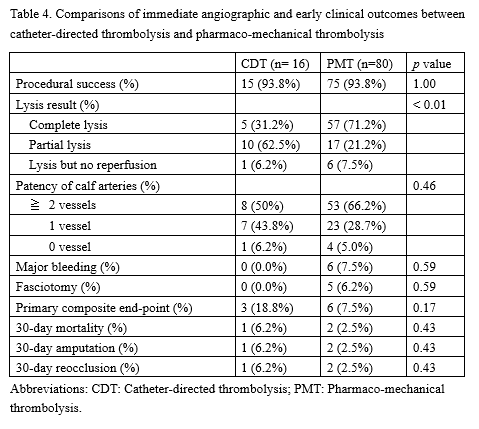




Conclusion
Compared with CDT, PMT for acute limb ischemia could significantly reduce the thrombolytic drug dosage and duration required for reperfusion of ischemic limb and improve the complete lysis rate.


